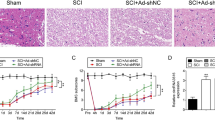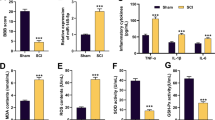Abstract
Accumulating evidence supports that Sirtuin 6 (SIRT6) may play a vital role in the pathogenesis of spinal cord injury. The current study was designed to investigate the specific effects of SIRT6 on spinal cord injury (SCI). HE and Nissl staining were performed for pathological analysis in SCI rats. SIRT6 expression was detected by RT-qPCR. CCK8 assay was applied for the detection of cell viability of LPS-injured PC12 cells. TNF-a, IL-1β, IL-6, MCP-1 levels and ROS, MPO, SOD levels were assessed to evaluate inflammation and oxidative stress in spinal cord injury. Cell apoptosis were evaluated by morphological examination using AO/EB fluorescent staining methods and key proteins related to apoptosis were explored via western blot. HE staining revealed increased cavity involving the dorsal white matter and central gray matter, and Nissl staining discovered the loss of motor neurons in the ventral horn in SCI rats. SIRT6 had lower expression in SCI rats. Lipopolysaccharide (LPS) exposure induced cell apoptosis and reduced the expression of SIRT6. Mechanistically, we revealed that up-regulation of SIRT6 alleviated inflammation and oxidative stress and inhibited cell apoptosis in spinal cord injury. Together, our findings indicated that SIRT6 attenuated spinal cord injury by suppressing inflammation, oxidative stress, and cell apoptosis. This study demonstrates that SIRT6 may represent a protective effect against spinal cord injury.




Similar content being viewed by others
References
Duo, Z., and X.J. He. 2015. Advances in mechanisms of treatment for spinal cord injury with lithium. Zhongguo Gu Shang 28: 679–682.
White, A.R., and G.M. Holmes. 2019. Investigating neurogenic bowel in experimental spinal cord injury: Where to begin. Neural Regeneration Research 14: 222–226.
LaVela, S.L., K. Landers, B. Etingen, V.P. Karalius, and S. Miskevics. 2015. Factors related to caregiving for individuals with spinal cord injury compared to caregiving for individuals with other neurologic conditions. The Journal of Spinal Cord Medicine 38: 505–514.
Sobrido-Cameán, D., and A. Barreiro-Iglesias. 2018. Role of Caspase-8 and Fas in cell death after spinal cord injury. Frontiers in Molecular Neuroscience 11: 101.
Fournely, M., Y. Petit, É. Wagnac, J. Laurin, V. Callot, and P.J. Arnoux. 2018. High-speed video analysis improves the accuracy of spinal cord compression measurement in a mouse contusion model. Journal of Neuroscience Methods 293: 1–5.
Pinchi, E., A. Frati, S. Cantatore, S. D'Errico, R. Russa, A. Maiese, M. Palmieri, A. Pesce, R.V. Viola, P. Frati, and V. Fineschi. 2019. Acute spinal cord injury: A systematic review investigating miRNA families involved. International Journal of Molecular Sciences 20.
Zhong, Z.X., S.S. Feng, S.Z. Chen, Z.M. Chen, and X.W. Chen. 2019. Inhibition of MSK1 promotes inflammation and apoptosis and inhibits functional recovery after spinal cord injury. Journal of Molecular Neuroscience 68: 191–203.
Park, C.S., J.Y. Lee, H.Y. Choi, B.G. Ju, I. Youn, and T.Y. Yune. 2019. Protocatechuic acid improves functional recovery after spinal cord injury by attenuating blood-spinal cord barrier disruption and hemorrhage in rats. Neurochemistry International 124: 181–192.
Dai, H., D.A. Sinclair, J.L. Ellis, and C. Steegborn. 2018. Sirtuin activators and inhibitors: Promises, achievements, and challenges. Pharmacology & Therapeutics 188: 140–154.
Strycharz, J., Z. Rygielska, E. Swiderska, J. Drzewoski, J. Szemraj, L. Szmigiero, and A. Sliwinska. 2018. SIRT1 as a therapeutic target in diabetic complications. Current Medicinal Chemistry 25: 1002–1035.
Gertler, A.A., and H.Y. Cohen. 2013. SIRT6, a protein with many faces. Biogerontology 14: 629–639.
Kugel, S., and R. Mostoslavsky. 2014. Chromatin and beyond: The multitasking roles for SIRT6. Trends in Biochemical Sciences 39: 72–81.
He, Y., Y. Xiao, X. Yang, Y. Li, B. Wang, F. Yao, C. Shang, Z. Jin, W. Wang, and R. Lin. 2017. SIRT6 inhibits TNF-α-induced inflammation of vascular adventitial fibroblasts through ROS and Akt signaling pathway. Experimental Cell Research 357: 88–97.
Zhang, L., L. Bai, Q. Ren, G. Sun, and Y. Si. 2018. Protective effects of SIRT6 against lipopolysaccharide (LPS) are mediated by deacetylation of Ku70. Molecular Immunology 101: 312–318.
Powell, A., and L. Davidson. 2015. Pediatric spinal cord injury: A review by organ system. Physical Medicine and Rehabilitation Clinics of North America 26: 109–132.
Nas, K., L. Yazmalar, V. Şah, A. Aydın, and K. Öneş. 2015. Rehabilitation of spinal cord injuries. World Journal of Orthopedics 6: 8–16.
Sánchez-Ventura, J., J. Amo-Aparicio, X. Navarro, and C. Penas. 2019. BET protein inhibition regulates cytokine production and promotes neuroprotection after spinal cord injury. Journal of Neuroinflammation 16: 124.
Zhang, Y., L. Wang, L. Meng, G. Cao, and Y. Wu. 2019. Sirtuin 6 overexpression relieves sepsis-induced acute kidney injury by promoting autophagy. Cell Cycle 18: 425–436.
Hu, W., H. Wang, Z. Liu, Y. Liu, R. Wang, X. Luo, and Y. Huang. 2017. Neuroprotective effects of lycopene in spinal cord injury in rats via antioxidative and anti-apoptotic pathway. Neuroscience Letters 642: 107–112.
Liu, G., G. Fan, G. Guo, W. Kang, D. Wang, B. Xu, and J. Zhao. 2017. FK506 attenuates the inflammation in rat spinal cord injury by inhibiting the activation of NF-κB in microglia cells. Cellular and Molecular Neurobiology 37: 843–855.
Reed, J.C. 2006. Proapoptotic multidomain Bcl-2/Bax-family proteins: Mechanisms, physiological roles, and therapeutic opportunities. Cell Death and Differentiation 13: 1378–1386.
Crowley, L.C., and N.J. Waterhouse. 2016. Detecting cleaved Caspase-3 in apoptotic cells by flow cytometry. Cold Spring Harbor Protocols.
Availability of Data and Materials
The analyzed data sets generated during the present study are available from the corresponding author on reasonable request.
Author information
Authors and Affiliations
Contributions
All authors made substantial contributions to the design of the study, performed the experiments, and analyzed the data.
Corresponding author
Ethics declarations
Competing Interests
All authors read and approved the final version of the manuscript. All authors declare that they have no competing interests.
Additional information
Publisher’s Note
Springer Nature remains neutral with regard to jurisdictional claims in published maps and institutional affiliations.
Rights and permissions
About this article
Cite this article
Zhaohui, C., Shuihua, W. Protective Effects of SIRT6 Against Inflammation, Oxidative Stress, and Cell Apoptosis in Spinal Cord Injury. Inflammation 43, 1751–1758 (2020). https://doi.org/10.1007/s10753-020-01249-2
Published:
Issue Date:
DOI: https://doi.org/10.1007/s10753-020-01249-2




